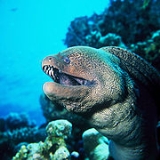
Giant moray
Encyclopedia
The giant moray is the largest of the Moray eel
s, in terms of body mass (the slender giant moray
is longer).
region, being found in the Red Sea
and East Africa
, the Pitcairn group, north to the Ryukyu and Hawaiian islands
, south to New Caledonia
, Fiji
and the Austral Islands
.
, reaching up to 300 cm (10.0 ft) in length and 30 kg (66.1 lbs) in weight. While juveniles are tan in colour with large black spots, adults have black specks that grade into leopard-like spots behind the head and a black area surrounding the gill
opening.
s and seaward reef
s.
Moray eel
Moray eels are cosmopolitan eels of the family Muraenidae. The approximately 200 species in 15 genera are almost exclusively marine, but several species are regularly seen in brackish water and a few, for example the freshwater moray can sometimes be found in freshwater...
s, in terms of body mass (the slender giant moray
Slender giant moray
The slender giant moray or gangetic moray, Strophidon sathete, is the longest member of the family of moray eels. Specimen as large as 4 m have been recorded...
is longer).
Range
The giant moray is widespread in the Indo-PacificIndo-Pacific
The Indo-Pacific is a biogeographic region of the Earth's seas, comprising the tropical waters of the Indian Ocean, the western and central Pacific Ocean, and the seas connecting the two in the general area of Indonesia...
region, being found in the Red Sea
Red Sea
The Red Sea is a seawater inlet of the Indian Ocean, lying between Africa and Asia. The connection to the ocean is in the south through the Bab el Mandeb strait and the Gulf of Aden. In the north, there is the Sinai Peninsula, the Gulf of Aqaba, and the Gulf of Suez...
and East Africa
East Africa
East Africa or Eastern Africa is the easterly region of the African continent, variably defined by geography or geopolitics. In the UN scheme of geographic regions, 19 territories constitute Eastern Africa:...
, the Pitcairn group, north to the Ryukyu and Hawaiian islands
Hawaiian Islands
The Hawaiian Islands are an archipelago of eight major islands, several atolls, numerous smaller islets, and undersea seamounts in the North Pacific Ocean, extending some 1,500 miles from the island of Hawaii in the south to northernmost Kure Atoll...
, south to New Caledonia
New Caledonia
New Caledonia is a special collectivity of France located in the southwest Pacific Ocean, east of Australia and about from Metropolitan France. The archipelago, part of the Melanesia subregion, includes the main island of Grande Terre, the Loyalty Islands, the Belep archipelago, the Isle of...
, Fiji
Fiji
Fiji , officially the Republic of Fiji , is an island nation in Melanesia in the South Pacific Ocean about northeast of New Zealand's North Island...
and the Austral Islands
Austral Islands
The Austral Islands are the southernmost group of islands in French Polynesia, an overseas collectivity of France in the South Pacific. Geographically, they consist of two separate archipelagos, namely in the northwest the Tubuai Islands consisting of the Îles Maria, Rimatara, Rurutu, Tubuai...
.
Description
As the name suggests, this is a large eelEel
Eels are an order of fish, which consists of four suborders, 20 families, 111 genera and approximately 800 species. Most eels are predators...
, reaching up to 300 cm (10.0 ft) in length and 30 kg (66.1 lbs) in weight. While juveniles are tan in colour with large black spots, adults have black specks that grade into leopard-like spots behind the head and a black area surrounding the gill
Gill
A gill is a respiratory organ found in many aquatic organisms that extracts dissolved oxygen from water, afterward excreting carbon dioxide. The gills of some species such as hermit crabs have adapted to allow respiration on land provided they are kept moist...
opening.
Habitat
Found in lagoonLagoon
A lagoon is a body of shallow sea water or brackish water separated from the sea by some form of barrier. The EU's habitat directive defines lagoons as "expanses of shallow coastal salt water, of varying salinity or water volume, wholly or partially separated from the sea by sand banks or shingle,...
s and seaward reef
Reef
In nautical terminology, a reef is a rock, sandbar, or other feature lying beneath the surface of the water ....
s.
Hazards
This species may be hazardous to people in two ways:- Being at the top of the food chainFood chainA food web depicts feeding connections in an ecological community. Ecologists can broadly lump all life forms into one of two categories called trophic levels: 1) the autotrophs, and 2) the heterotrophs...
it is likely to cause ciguateraCiguateraCiguatera is a foodborne illness caused by eating certain reef fishes whose flesh is contaminated with toxins originally produced by dinoflagellates such as Gambierdiscus toxicus which lives in tropical and subtropical waters. These dinoflagellates adhere to coral, algae and seaweed, where they are...
poisoning if eaten. - It has been implicated in provoked and unprovoked attacks on scuba divers.
External links
- http://moray-eel.com/ Moray Eel Database

